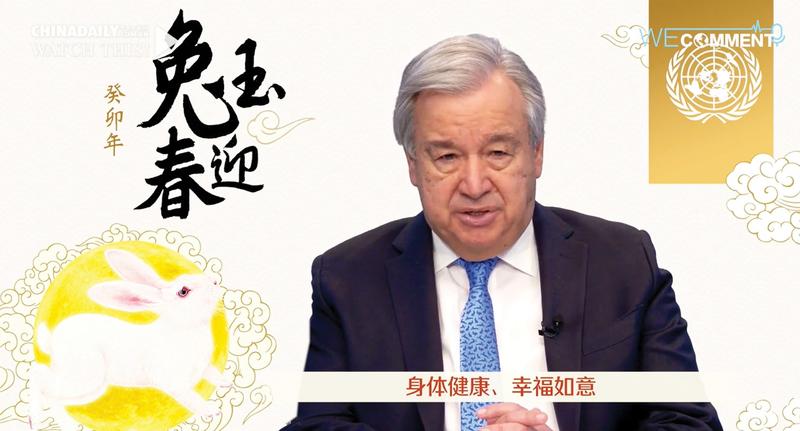Destinations around the world are eager to welcome travelers from key source after long pandemic hiatus
 A guest paints on the eye of a lion costume as a part of the Chinese traditional ritual before a lion dance performance in the China Town area of Riyadh, Saudi Arabia, on Jan 14. The event was held to welcome the Chinese New Year of the Rabbit. (WANG HAICHUAN / XINHUA)
A guest paints on the eye of a lion costume as a part of the Chinese traditional ritual before a lion dance performance in the China Town area of Riyadh, Saudi Arabia, on Jan 14. The event was held to welcome the Chinese New Year of the Rabbit. (WANG HAICHUAN / XINHUA)
Alight-up ceremony in Bangkok kicked off celebrations for the Chinese Lunar New Year of the Rabbit on the evening on Jan 16, with Thailand’s biggest international airport expected to welcome more than 1.8 million Chinese tourists in the following two weeks.
In Bangkok’s Chinatown, officials in attendance at the ceremony included Tourism Authority of Thailand Governor Yuthasak Supasorn and Chinese embassy charge d’affaires Yang Xin, as both the Thais and foreign tourists enjoy the bright and colorful festival lanterns and lights.
“The Chinese New Year is one of the most important festivals celebrated in Thailand. It has been one of the key cultural links for the century-long friendship of Thailand and China,” Thai Minister of Tourism and Sports Phiphat Ratchakitprakarn said during the ceremony. “I believe we will welcome more Chinese tourists this year.”
Jan 22 marks the beginning of the Chinese Lunar New Year of the Rabbit, which is celebrated by overseas Chinese communities around the world, from the Middle East and Asia to the United States and Europe.
“It has been three years since we launched such large-scale Chinese Lunar New Year celebrations in Thailand, due to the COVID-19 pandemic,” Yang said. “This year’s celebration back to normal is really encouraging.”
Yang said the Thais’ efforts in holding such celebrations carry significance for the mutual sharing of festive happiness and prosperity.
“I hope the celebrations … (herald) a deeper and closer cooperative relation(ship) between China and Thailand,” Yang said. “And I’m also looking forward to seeing more Chinese tourists visit Thailand, exploring its beautiful natural scenery, and cultural diversity, and enjoying the enthusiasm of people from the smiling country.”
According to local media, Thailand has been among the top travel destinations ahead of the Chinese Lunar New Year. The capital’s biggest international airport, Suvarnabhumi Airport, was expected to welcome more than 1.8 million Chinese tourists between Jan 16 and Jan 28.
At the end of last month, the Chinese government announced it would remove certain COVID-19 restrictions on international passenger flights from Jan 8, paving the way for many Chinese to plan overseas trips this year.
In a quick response to the announcement, embassies and tourism boards worldwide posted messages on Chinese social media platform Weibo welcoming Chinese tourists again after a long hiatus.
 Ahead of the Spring Festival, or Lunar New Year, which falls on Jan 22, UN Secretary-General António Guterres sends his festive greetings to Chinese people all over the world, wishing them a happy Chinese New Year. The upcoming Spring Festival marks the beginning of the Year of the Rabbit. He said the rabbit is a symbol of energy and dexterity which are qualities we need as humanity faces hardship and tests in these new beginnings. (PHOTO PROVIDED TO CHINA DAILY)
Ahead of the Spring Festival, or Lunar New Year, which falls on Jan 22, UN Secretary-General António Guterres sends his festive greetings to Chinese people all over the world, wishing them a happy Chinese New Year. The upcoming Spring Festival marks the beginning of the Year of the Rabbit. He said the rabbit is a symbol of energy and dexterity which are qualities we need as humanity faces hardship and tests in these new beginnings. (PHOTO PROVIDED TO CHINA DAILY)
European destinations and tourism experts hailed China’s move, saying the new measures will be of great significance to the recovery of international tourism.
“I think this is a very natural reaction,” said Emanuel Lehner-Telic, head of markets Asia-Pacific at the Austrian National Tourist Office. “If you have not seen someone for a long while and missed them, you want to welcome them back.
“China was one of the largest tourism outbound markets until the end of 2019. A comeback of such a big player has of course an impact on the global tourism industry.”
David Boyce, head of Asia, Middle East and Emerging Markets at Tourism Ireland, said: “This is probably one of the best and the most exciting pieces of news we have heard for a long time … I know our industry, including hotels and attractions, just cannot wait to have Chinese people back.”
Chinese outbound tourism was stalled over the past three years, but Boyce said: “When things start to build up it will be floodgates opening.”
In two years Ireland will be welcoming double the number of Chinese visitors the country received in 2019, he said.
Daniela Chiani, Greater China director at Switzerland Tourism, said: “The latest measures issued by the Chinese government optimizing the COVID-19 prevention policy are inspiring. China has paved the way for a full recovery of the inbound and outbound tourism markets by adjusting its measures of epidemic prevention and control, in line with public expectations.”
The number of overnight stays in Switzerland by Chinese guests in 2019 reached 1.8 million, the country’s national tourism agency said.
“China is an important foreign source market for the Swiss tourism industry,” Chiani said.
Chinese tourists made about 170 million international trips in 2019, according to the China Outbound Tourism Research Institute. They were not only the biggest source market, but also the biggest spenders in international tourism.
Wolfgang Arlt, the institute’s director, said: “The Chinese had three years to remember their own trips, and read and see videos about destinations on social media and other sources. Many Chinese will have developed plans to do specific things during their next trip and go to new destinations, offering good opportunities for destinations off the beaten track, if they prepare well for the market.”
He forecast that the number of Chinese trips abroad this year will reach about two-thirds of what they were in 2019, possibly a bit less for Europe, and by next year, if no new problems arise, the 2019 level should be reached again.
Oliver Sedlinger, an international tourism consultant in Beijing for Sedlinger and Associates, said: “There definitely is a huge pent-up demand for outbound travel in China, and I think that during 2023 this demand will become increasingly visible. Once the final hurdles and bottlenecks are overcome, (for example) regulations, visa handling and flight capacity, I expect a very strong rebound.”
Indonesia is among the many countries that have introduced measures to welcome Chinese tourists since China started implementing its new measures on cross-border travel.
Indonesian Ambassador Djauhari Oratmangun said on Jan 13 that his country welcomes Chinese people for visits after Beijing optimized its COVID-19 response policy.
He said Chinese people who want to enter Indonesia for purposes such as tourism, government duties, business meetings, purchasing goods and transit are eligible to apply for a visa on arrival, which enables a maximum stay of 60 days.
“Indonesia is wonderful and beautiful, please do come,” he said, noting that a company based in Hangzhou, Zhejiang province, has planned to organize a conference for 200 to 300 people on the Indonesian island of Bali.
Indonesian Minister for Tourism and Creative Economy Sandiaga Uno said on Jan 9 at a news briefing in Jakarta, Indonesia’s capital, that the Southeast Asian country expects at least 253,000 tourists from China this year.
Mbelwa Kairuki, Tanzania’s ambassador in Beijing, told China Daily that after three years of waiting, he was glad to welcome Chinese tourists to his homeland, where people can visit Serengeti National Park to see the world’s second-largest mammal migration or climb Mount Kilimanjaro, which is also known as the “rooftop of Africa”.
Meanwhile, Lourdes Tanhueco Nepomuceno, director of the Confucius Institute at the University of the Philippines, is expecting an influx of Chinese tourists to the Philippines. China is one of the biggest markets for the Philippine travel and tourism industry.
“The Chinese culture in the Philippines impacts the lives of the majority of Filipinos,” Nepomuceno said, noting that many Filipinos celebrate the Chinese New Year.
Aaron Jed Rabena, research fellow at the Manila-based Asia Pacific Pathways to Progress, welcomes the return of Chinese tourists, noting that this will boost people-to-people exchanges and diplomatic ties.
“Personal touch really matters in diplomacy,” Rabena said.
Austin Ong, a research coordinator at the Integrated Development Studies Institute, a Manila-based think tank, said that by traveling to the Philippines, Chinese visitors can “feel and experience” what the Philippines has to offer, and strengthen people-to-people relationships.
Prime Sarmiento in Manila contributed to this story.
Contract the writers at yangwanli@chinadaily.com.cn


